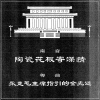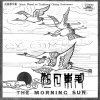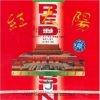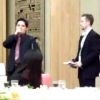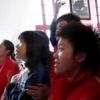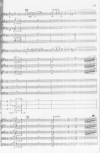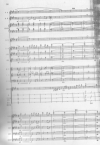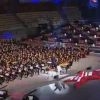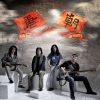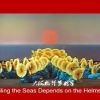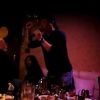Chapter 2: The Sounds amidst the Fury
When I was not racing the pigs, I was singing. Folk songs, foreign songs, revolutionary operas... Others were doing the same. I could hear them from a distance. Why did we do this? I cannot speak for others. In my case, I felt that when I started to sing, the pigs stopped running and fighting. They grew calm. (Rae Yang, 1950–)
In the loudspeakers back then, it was all revolutionary songs. Now these songs have become popular again. The reasons for this revival are complicated. We knew these songs so extremely well, and now they have changed these songs, adding rock rhythms and so on. I do like listening to them; it is interesting what they made out of them. (Journalist, 1949–)
Model works and revolutionary songs were the accepted staple of musical life in China during the Cultural Revolution. Officially, at least, there was to be no other music. And yet, such political dictatorship over “correct sounds” is not an invention of the Cultural Revolution. Indeed, the 9000-year-old bone flutes excavated at Jiahu in Henan, most probably the world’s oldest instruments in existence and yet possessing an intricate tuning system, indicate that even during neolithic times, China’s rulers believed in a close connection between the orders of music and the world (Zhang et al., 1999).
Confucius and the Chinese Classics warn of the dangers of performing the wrong type of music. “If all the notes are unclear and clash disagreeably with one another, there will be general confusion and in the near future, state and people will face disaster and annihilation” warns the Classic of Music (乐记 Yueji) (Kaufmann 1976, 33). Accordingly, every ruler had to pay close attention to the sounds proliferating in his country. Changes in the musical system, so it was believed, could cause changes in the cosmos and the world. If the Yellow Bell (黄钟 huangzhong), since time immemorial the base note for the twelve-tone scale, was found to be out of tune, it could lead to the fall of the country. Thus, it is no surprise that Chinese rulers were meticulous in keeping the Yellow Bell tuned. They also collected folksongs in order to be informed about the state of their rulership, later revising these songs and teaching them to the people again in order to improve their minds and to stabilize their government (Kaufmann 1976, 38).
Chinese politicians of the (post-)modern age have evidently not lost this faith in the profound meaning and power of sound and music. All political groups made use of songs based on foreign and, less often, Chinese folk melodies that were then fitted with new texts. After the foundation of the CCP in 1921, Soviet songs became more and more influential (Yu 2006), as the singing of songs was part and parcel of Communist guerilla practice. In 1929, during the Gutian Conference, this practice was institutionalized: singing revolutionary songs became an integral part of cadre training (Wong 1984, 121). In Yan’an, the idea was further developed at the Lu Xun Academy, founded in 1938, where it was decided that musicians and composers would go to the masses to collect folk songs and forms of folk theater. They would eradicate “feudal” and “bourgeois” remnants from these pieces of music and then, through traveling music troupes, teach them again to the people, in their now “purified” form (Holm 1991).
In 1942, when Mao formulated his famous Yan’an Talks, he prescribed the ultimate aim and form of all orthodox art and music, and his dictate remains binding in revolutionary China to the present day. “Correct music” is expected to be both modern and Chinese at the same time. It is bound by politics to “serve the people” by combining the best of China’s national traditions with the most useful elements from foreign traditions. It must be revolutionary (革命化 geminghua), have national style (民族化 minzuhua), and serve the masses (大众化 dazhonghua) (Mao 1942).
In chapter 2, I demonstrate that even the most characteristic sounds and melodies of the Cultural Revolution, repeated ad nauseam as long as it lasted, were originally conceived many decades before the Cultural Revolution had begun. I explain why their influence has not waned even today, long after the Cultural Revolution has officially ended. Until recently, even internationally recognized pop and contemporary music stars Cui Jian and Tan Dun, respectively, have been taking up, repeating, and varying on the sounds and ideas of China’s “Red Revolution.” Cultural Revolution music, “the sounds amidst the fury,” is thus not the exceptional, unprecedented phenomenon it is quite frequently portrayed to be; it is less the deviation than the norm of (orthodox political) culture in revolutionary China.
This is so, in spite of the fact that the alleged “Sounds of the Cultural Revolution” will cause in some (many illustrious names such as writer Ba Jin and composer Zhu Jian’er among them) feelings of extreme revulsion and even physical pain, because they force people to remember a time of terror and repression. Rae Yang’s loathings are surely not an exception:
“The East is red. The sun rises. China... Mao Zedong...” Oh.
Miserable! Just as I was about to fall asleep this damn song starts. At five thirty! Every day. Seven days a week . . . . Never gives anybody a break . . . . I hate this song now! I used to love it . . . . Things change into their opposites . . . . Red Guards. Class enemies ... I wonder if any counterrevolutionary can match me in hating this song. It’s not music. It’s torture! Pouring out of a loudspeaker in a pine tree just outside my bedroom window. It drives me crazy! Are there bedrooms in this college that don’t have loudspeakers blaring into them? Guess not.
At daybreak, the whole college was drowned in this deafening music. Teachers, students, workers, their families, all were forced to wake up. Other colleges and universities in Beijing were pretty much the same. When “The East is red,” was playing, everybody had to get up except a few leaders, such as Chairman Mao himself.
The broadcast, once it started, would not stop for at least two hours. The network news followed the song. Then local news, all kinds of announcements, declarations, orders, ultimatums, selected dazibao ... It went on and on . . . . I am willing to sell my soul to the devil himself if he can teach me how to silence that loudspeaker. Loose contact? A wire broken from the inside? Pull the magnet out? (Yang 1997, 157–58)
During the Cultural Revolution, revolutionary songs such as “Red Is the East,” i.e. the “sounds amid the fury,” were inescapable. Why is much of this type of music still present in China today—not only on an official website celebrating the sixtieth anniversary of the founding of the PRC, where it is argued that revolutionary songs like “Red Is the East” have become increasingly popular over the years, thriving along with the fruits of “liberation,” the rise of China, and a love for Mao and the Party —but also at Tian’anmen in 1989, when students protested against their government by singing revolutionary songs (Pecore et al. 1999)? Why is this music still alive as part of the popular Mao revival of the early 1980s, which was boosted in the early 1990s with the publication of revolutionary songs to new beats (as discussed recently by Sue Tuohy and Gregory Lee)? What was the propaganda message in these songs and to what extent did the songs ever instill “blind faith” in the minds of listeners? And would this faith survive in the songs’ later retakes? (Lu 2004, 122)
It is the purpose of this chapter to deliberate these questions by discussing music that was everpresent not just during the Cultural Revolution: the revolutionary songs in praise of Mao, or “MaoMusic.” In doing so, I offer an alternative reading of this musical experience of the Cultural Revolution, showing how these much maligned “sounds amidst the fury” served many earlier revolutions and how they remain the staple for Chinese music-making after Mao, hitting on many a music lover’s taste in a market diffused with Mao memorabilia in recent years.







